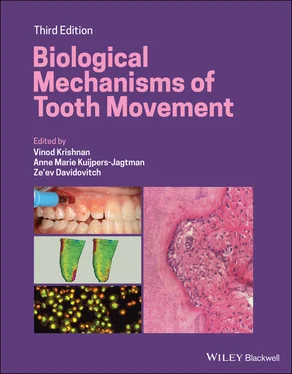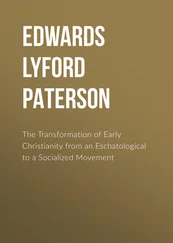The process of resorption requires specific interactions between various inflammatory cells and hard tissues, whether bone, cementum, or dentine. It is a multistep process. The underlying cellular processes involved in root resorption are thought to be similar if not identical to those that occur during bone resorption, which allow the expected and nonpathological tissue changes that result in the effective tooth movement in response to orthodontic forces (Pierce et al ., 1991). Multinucleated clast cells are formed as a result of cellular injuries to bone, cementum, or dentine (Boyde et al ., 1984). The progenitor cells arrive at the resorption site via the bloodstream as mononuclear cells, derived from hemopoietic precursors in the spleen or bone marrow, which fuse prior to getting involved in the resorptive process. Its pathogenesis has been assumed to be the removal of necrotic tissue from areas of the PDL that have been compressed by an orthodontic load. It is believed that PGs are involved in root resorption (Seifi et al ., 2003), and that inflammatory cytokines and chemokines can play a role in this process (Yamaguchi et al ., 2008; Asano et al ., 2011; Curl and Sampson, 2011; Diercke et al ., 2012). While specific data regarding the molecular basis of root resorption is relatively scarce, at this point it is possible to consider that similar mechanisms seems to operate in the “constructive” inflammation that mediates tooth movement, and in the “destructive” inflammation that results in root resorption. However, it is still unclear if differences in the intensity of the inflammatory process could explain the constructive/destructive dichotomy. Low et al . (2005) reported that RANK and OPG regulated the root resorption process. Yamaguchi et al . (2006) reported that the compressed PDL cells obtained from patients with severe EARR produce a large amount of RANKL and up‐regulate osteoclastogenesis. It was recently demonstrated that IL‐1β and compressive forces lead to a significant induction of RANKL‐expression in cementoblasts, suggesting that the activation of this specific cell type could direct the resorptive response to the apex area (Diercke et al ., 2012). Furthermore, exposure to excessive orthodontic force by the PDL of rats produced IL‐6, IL‐8, IL‐17 in resorbed root, and these cytokines may be associated with the deterioration of root resorption (Asano et al., 2011; Hayashi et al ., 2012; Yamada et al ., 2013).
There have been some reports that systemic forms of chronic inflammation may exacerbate the inflammatory response during OTM, and thus predispose the teeth to increased root resorption. McNab et al . (1999) found that asthmatic patients, both well controlled with medication as well as nonmedicated individuals, have an increased incidence of orthodontically induced EARR in their maxillary molars. This observation was supported by other researchers (Owman‐Moll and Kurol, 2000), and it is also supported by the comorbidity concept, which states that a pre‐existing inflammatory condition may modify the response to a subsequent stimulus. In this context, the response to the secondary stimulus is clearly exacerbated, and can result in the development of a pathological reaction, which would not take place without the primed inflammatory status (Trombone et al ., 2010; Queiroz‐Junior et al ., 2011; Claudino et al ., 2012). Translating such a concept to the OTM scenario, if such chronic inflammation does indeed exacerbate the underlying inflammation in OTM, then, logically, elimination of the chronic inflammation should reduce the increased incidence of root resorption. Accordingly, it has been reported that prednisolone treatment (as used in the treatment and prevention of asthma) leads to significantly less root resorption during OTM (Ong et al ., 2000).
Root resorption is believed to be related initially to the force magnitude, and light forces have long been recommended for minimizing this adverse outcome. However, recent reports indicate that force magnitude may not be the most decisive etiologic factor responsible for root resorption, and that the severity of this condition is highly related to the regimen of force application. In this regard, intermittent forces cause less severe root resorption than continuously applied forces (Acar et al ., 1999; Maltha et al ., 2004).
A search for risk factors affiliated with the development of EARR during orthodontic treatment has led to the suggestion that individual susceptibility, genetics, and systemic factors may be significant modulators of this process. Current research on orthodontic root resorption is directed toward identifying genes involved in the process, their chromosome loci, and their possible clinical significance. Al‐Qawasmi et al . (2003) firstly reported evidences of linkage disequilibrium of IL‐1β polymorphism in allele 1 and EARR. Subsequently, other groups replicated the possible association of IL‐1β genetic variants with the root‐resorption process (Bastos Lages et al ., 2009; Urban and Mincik, 2010; Iglesias‐Linares et al ., 2012), and also suggested the involvement of polymorphisms in other genes, such as the vitamin D receptor (Fontana et al ., 2012). Experimental data from inbred mouse strains reinforce the hypothesis that the genetic background presents a significant impact in experimentally induced root resorption (Al‐Qawasmi et al ., 2006). Recent studies reported the extent of genetic influence in the root resorption process in humans. In their review on cellular and molecular pathways in the external root resorption process. Iglesias‐Linares and Hartsfield (2017) described clast cell adhesion and the specific role of α/β integrin, osteopontin, and related extracellular matrix proteins, as well as clast cell fusion and activation by the RANKL/OPG and ATP‐P2RX7‐IL‐1 pathway. On the other hand, the meta‐analysis by Nowrin et al . (2018) showed that the IL‐1β polymorphism is not associated with a predisposition to external apical root resorption. Further research is needed about the extent of genetic influence in the root resorption process.
From the above, root resorption may be regulated by genetic factors and inflammatory cytokines. The role of cytokines as well as neuropeptides, released in response to orthodontic force application, in producing root resorption is outlined in Figure 4.5.
Root resorption in the cementum
Cementum contains 65% inorganic material and 12% water on a wet‐weight basis. By volume, inorganic material comprises approximately 45%, organic material 33%, and water 22%. Cementum is less densely mineralized than dentine and enamel, contains no blood vessels, and does not undergo physiological remodelling (Selving et al., 1962; Neiders et al ., 1972; Cohen et al ., 1992). The chemical composition of cementum may vary by individual, and morphologically, cementum is classified as both cellular and acellular (Foster, 2017).
Chutimanutskul et al . (2005) examined the physical properties of the cementum on the buccal and lingual surfaces of the roots at the cervical third, middle third, and apical third. The authors reported a decreasing gradient in the hardness and elastic modulus of cementum in both surface groups, from the cervical to apical thirds. Apical cementum is predominately cellular, less densely mineralized, and has lower hardness and elastic modulus values than the more densely mineralized acellular cementum found in the middle and cervical thirds of the root (Foster, 2017) . Therefore, the hardness and elastic modulus of cementum depend on the direction of the structural arrangement and the mineral content of the cementum (Henry and Weinmann, 1951; Jones and Boyde, 1972; Rex et al ., 2005). Several studies have reported that the hardness of mineralized tissues was positively correlated with the extent of mineralization (Brear et al ., 1990; Mahoney et al ., 2000; Malek et al ., 2001). Some have suggested that the mineral content of cementum might influence the resistance or susceptibility to root resorption.
Читать дальше












